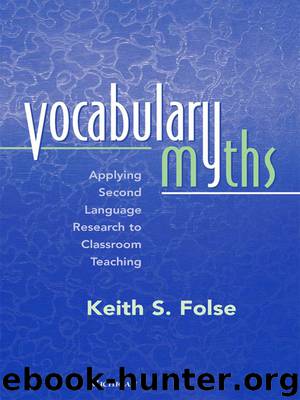Vocabulary Myths: Applying Second Language Research to Classroom Teaching by Folse Keith S

Author:Folse, Keith S.
Language: eng
Format: epub
Publisher: The University of Michigan Press
How does this layout encourage and facilitate student opportunities for retrieval of the vocabulary? With this design, the four pieces of information about each entry are in the same place on the page—e.g., the translation is always in the top right corner of each entry and the collocation example is always in the bottom right.
The first four retrieval possibilities are vertical pairings that allow the following question/prompt-to-answer pairings: (1) word → synonym, (2) synonym → word, (3) translation → collocation, and (4) collocation → translation. To do any of these four, learners must fold the page vertically so that only one column—i.e., the entire left column (for #1 and #2) or the entire right column (for #3 or #4)—is visible. Learners should then cover the entire column with another piece of paper or large card.
To retrieve an English synonym or definition of the vocabulary, students should fold the right column under the left column so that only half of the page (vertically) is visible—i.e., the left half. Students then cover up everything in the column except the very top word and work their way down the page exposing only the vocabulary word at first, pausing to recall/retrieve the synonym, and then pulling the cover down to expose the correct answer. To retrieve the target word from the synonym, learners start with the last vocabulary item on the page and reverse the process moving upward on the page.
To practice retrievals of a translation from a collocation or vice-versa, the same procedures should be done on the right-hand column (with the left-hand column invisible). Again, spacing and neatness are important because these allow for all eight of these retrievals to be accomplished easily.
The other four retrieval possibilities are horizontal pairings that allow the following question/prompt-to-answer pairings: (1) word → translation, (2) translation → word, (3) synonym → collocation, and (4) collocation → synonym. To do any of these four, learners should create a special cover-up card or sheet of paper that is missing one corner (one-fourth). It should look like this:
Download
This site does not store any files on its server. We only index and link to content provided by other sites. Please contact the content providers to delete copyright contents if any and email us, we'll remove relevant links or contents immediately.
| Arts & Humanities | Health |
| Language Arts | Library Skills |
| Mathematics | Reading & Phonics |
| Science & Technology | Social Studies |
The Art of Coaching Workbook by Elena Aguilar(51077)
Trainspotting by Irvine Welsh(21571)
Twilight of the Idols With the Antichrist and Ecce Homo by Friedrich Nietzsche(18568)
Fangirl by Rainbow Rowell(9175)
Periodization Training for Sports by Tudor Bompa(8211)
Change Your Questions, Change Your Life by Marilee Adams(7684)
This Is How You Lose Her by Junot Diaz(6833)
Asking the Right Questions: A Guide to Critical Thinking by M. Neil Browne & Stuart M. Keeley(5708)
Grit by Angela Duckworth(5555)
Red Sparrow by Jason Matthews(5425)
Paper Towns by Green John(5138)
Room 212 by Kate Stewart(5071)
Ken Follett - World without end by Ken Follett(4683)
Housekeeping by Marilynne Robinson(4392)
The Sports Rules Book by Human Kinetics(4342)
Double Down (Diary of a Wimpy Kid Book 11) by Jeff Kinney(4240)
Papillon (English) by Henri Charrière(4227)
The Motorcycle Diaries by Ernesto Che Guevara(4050)
Exercise Technique Manual for Resistance Training by National Strength & Conditioning Association(4020)
